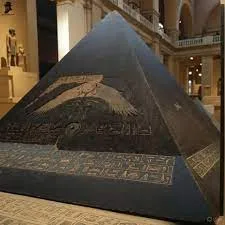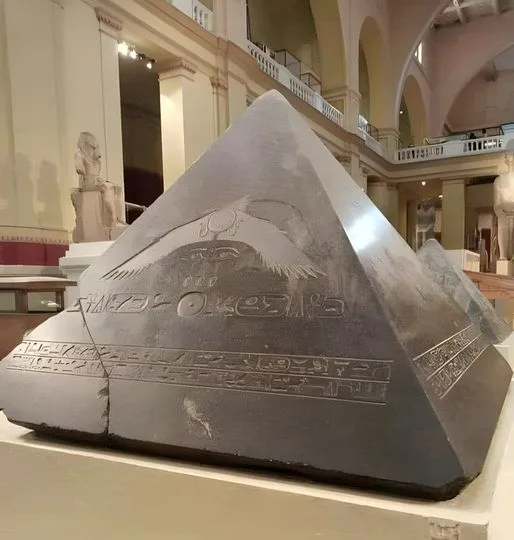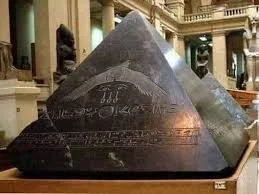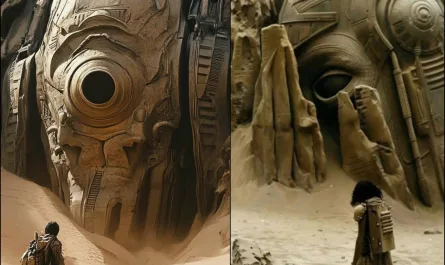The tale of the “Pyramid of Bin Bin,” a supposed ancient structure made from extraterrestrial black iron meteorite stone, has circulated online as a baffling mystery that stumped scientists for millennia. Described as impossibly hard to shape, requiring laser-like precision for its angles, polish, and inscriptions, and even emitting positive electromagnetic energy for psychological comfort, this pyramid sounds like a relic from another world. However, this story is a modern myth, blending exaggeration, pseudoscience, and misinterpretations of real ancient Egyptian artifacts. The “Bin Bin” pyramid likely refers to the Benben stone or the pyramidion of Amenemhat III’s Black Pyramid, a well-documented piece of history that holds no such enigmas.

The Myth Unraveled
The viral narrative claims the pyramid is built from black iron stone found only in space meteorites, making it extraordinarily durable yet brittle, with perfect angles and deflections that defy ancient tools. Its surfaces are said to be polished to unique refinement, inscribed with precision only achievable by modern lasers. Adding to the allure, the stone allegedly transmits positive electromagnetic energy, affecting human well-being. These elements paint a picture of an otherworldly artifact, but they stem from unsubstantiated online posts and social media, often shared without evidence.

In truth, no such “Pyramid of Bin Bin” exists as described. The name appears to be a transliteration or misspelling of “Benben,” a sacred stone in ancient Egyptian mythology associated with creation. The Benben was a symbolic mound or stone in Heliopolis, representing the primeval hill from which the sun god emerged. It inspired the capstones of pyramids, known as pyramidions, which topped these monuments to symbolize divine light.

The Real Artifact: Amenemhat III’s Pyramidion
The closest real counterpart is the pyramidion from Amenemhat III’s Black Pyramid at Dahshur, Egypt, crafted around 1850 BCE during the Middle Kingdom’s 12th Dynasty. This capstone, now housed in the Egyptian Museum in Cairo, is made of basalt—a dark, volcanic rock often called “black granite” for its polished sheen—not meteoritic iron. Basalt was commonly quarried in Egypt and shaped using bronze tools, abrasives like sand, and manual labor, techniques well-documented in ancient quarries.

The pyramidion measures about 1.4 meters high and 1.85 meters wide, weighing around 4.5 tons. Its surfaces are inscribed with hieroglyphs invoking gods like Ra, Osiris, and Anubis, praising the king’s divine connections. These carvings, while precise for the era, were achieved with copper chisels and stone hammers, not lasers—ancient Egyptians mastered stoneworking, as seen in obelisks and statues. No evidence suggests unusual hardness or impossibility; basalt is tough but workable, and the inscriptions show typical Middle Kingdom style, with some erasures possibly from later pharaohs like Akhenaten.

The “Black Pyramid” itself, named for its dark mudbrick core visible after limestone casing eroded, was a royal tomb, not a mysterious meteorite structure. Discovered protruding from sand in 1900 by archaeologist Gaston Maspero, the pyramidion was never linked to space origins or energy emissions in scholarly records.
Addressing the Claims
Material from Space? While some fringe theories speculate the original Benben stone in Heliopolis might have been an iron meteorite due to its conical shape and solar associations, no physical evidence supports this. Egyptian ironwork from meteors exists (like Tutankhamun’s dagger), but the Amenemhat pyramidion is confirmed basalt through petrographic analysis. The myth conflates this with unproven ideas.

Impossible to Carve? Ancient tools sufficed for basalt; Egyptians polished stones using quartz sand and manual rubbing, achieving smooth surfaces without modern tech. Lasers are unnecessary—precision came from skilled artisans using grids and templates.
Electromagnetic Energy? No scientific tests show the pyramidion emitting energy or affecting human psychology. Such claims echo pseudoscience, like crystal healing, without basis in archaeology or physics.
Puzzling Scientists for Millennia? The pyramidion has been studied since 1900, with clear conclusions on its origin, material, and purpose. The “thousands of years” puzzle is fabricated; ancient Egyptians documented their building techniques.

A Broader Pattern of Myths
This story fits a pattern of sensationalized ancient mysteries, often amplified online to suggest lost advanced knowledge or extraterrestrial involvement. Similar tales surround Egyptian artifacts, blending facts (like meteoritic iron use) with fiction. The Benben’s mythological role—as a creation symbol—inspired pyramid designs, but no evidence points to otherworldly properties.

The pyramidion’s real wonder lies in its historical context: capping a pharaoh’s tomb to invoke eternal life, reflecting Middle Kingdom artistry. As a relic of Amenemhat III’s reign, it highlights Egypt’s engineering legacy, not unsolved enigmas.
Preserving the True Legacy

While the “Bin Bin” myth captivates imaginations, it distracts from genuine archaeological insights. The pyramidion, displayed in Cairo, invites appreciation for ancient craftsmanship without needing embellishment. By debunking such tales, we honor the real ingenuity of past civilizations, ensuring history remains grounded in evidence rather than fantasy. The Black Pyramid’s capstone stands as a testament to human achievement, polished by time and skill, not lasers or meteors.





